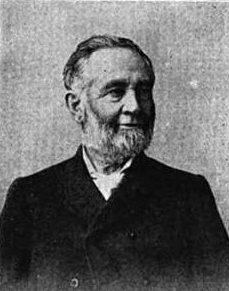
Scotland County is a county in northeastern Missouri. As of the 2020 census, its population was 4,716, making it Missouri's seventh-least populous county. Its county seat is Memphis. The county was organized on January 29, 1841, and named for Scotland.

The Battle of Kirksville was a battle in the American Civil War, fought in the town of Kirksville, Missouri, on August 6, 1862. The Union victory helped consolidate Federal control over northeastern Missouri.

The First Battle of Independence was a minor engagement of the American Civil War, occurring on August 11, 1862, in the city of Independence, located in Jackson County, Missouri. Its result was a Confederate victory, continuing the Southern domination of the Jackson County area for a few days while the recruiters completed their work.

The Battle of Lone Jack was a battle of the American Civil War, occurring on August 15–16, 1862 in Jackson County, Missouri. The battle was part of the Confederate guerrilla and recruiting campaign in Missouri in 1862.

Action at Springfield, also known as the Battle of First Springfield, was a battle of the American Civil War that took place on October 25, 1861, in Greene County, Missouri. It was the only Union victory in southwestern Missouri in 1861.
Joseph Chrisman Porter was a Confederate officer in the American Civil War, a key leader in the guerrilla campaigns in northern Missouri, and a figure of controversy. The main source for his history, Joseph A. Mudd is clearly an apologist; his opponents take a less charitable view of him, and his chief adversary, Union Colonel John McNeil, regarded him simply as a bushwacker and traitor, though his service under General John S. Marmaduke in the Springfield campaign and following clearly shows he was regarded as a regular officer by the Confederacy.

During the American Civil War, Arkansas was a Confederate state, though it had initially voted to remain in the Union. Following the capture of Fort Sumter in April 1861, Abraham Lincoln called for troops from every Union state to put down the rebellion, and Arkansas and several other states seceded. For the rest of the civil war, Arkansas played a major role in controlling the Mississippi River, a major waterway.

The 1st Arkansas Cavalry Regiment (1862–1865) was a cavalry regiment from the state of Arkansas that served in the Union Army during the American Civil War.

The Skirmish at Island Mound was a skirmish of the American Civil War, occurring on October 29, 1862, in Bates County, Missouri. The Union victory is notable as the first known event in which an African-American regiment engaged in combat against Confederate forces during the war.
The Enrolled Missouri Militia was a state militia organization of Missouri in 1862 during the American Civil War. It was a part-time force whose primary purpose was to serve as garrison and infrastructure guards, both to augment the Unionist Missouri State Militia in defense versus raids and to free the Missouri State Militia for offensive operations versus Confederate guerrillas and recruiters.

Odon Guitar was a general in the Union Missouri State Militia during the American Civil War. He was noted for his successful campaign against Joseph C. Porter and John A. Poindexter's recruiting commands in northern Missouri.
The Missouri State Militia was a federally funded state militia organization of Missouri conceived in 1861 and beginning service in 1862 during the American Civil War. It was a full-time force whose primary purpose was to conduct offensive operations against Confederate guerrillas and recruiters as well as oppose raids by regular Confederate forces. The militia at one time numbered more than 13,000 soldiers, but this force was reduced to 10,000 soldiers, by the United States government.
John A. Poindexter was a colonel in the Confederate Army during the American Civil War. He and Joseph C. Porter were the primary recruiting commanders in northern Missouri during 1862.

The Battle of Compton's Ferry, also known as Little Compton Ferry, was an action during the American Civil War, occurring along the Grand River in southwest Livingston County, Missouri. The battle lasted from August 10 to August 13, 1862.
The 2nd Missouri Cavalry Regiment, also known officially as Merrill's Horse, was a cavalry regiment that served in the Union Army during the American Civil War. The regiment was one of only a handful of Missouri regiments to be officially named as well as numbered.

The 1st Northeast Missouri Cavalry, or 1st NE Missouri Cavalry was a Confederate Army regiment during the American Civil War. One of the commanders was Colonel Joseph C. Porter, who led 125 men through the Battle of Moore's Mill. This regiment was known for its guerrilla warfare.
The 9th Missouri State Militia Cavalry Regiment, was a cavalry regiment that served as an element of the Union Army in the state of Missouri during the American Civil War. Unlike Militia units in other states, the 9th Missouri State Militia Cavalry was a full-time military unit, permanently engaged in internal counter-insurgency and protection of the state of Missouri from invasion by conventional Confederate units. The regiment was equipped and paid by the Federal government and was integrated into the Federal military structure in the Department of Missouri. The 9th MSM Cavalry was one of Missouri's most successful counter-guerrilla units.
The Battle of Yellow Creek, also known as Skirmish at Yellow Creek, was an action during the American Civil War, occurring August 13, 1862, along the Yellow Creek in Chariton County, Missouri.

7th Missouri Cavalry Regiment was a cavalry unit from Missouri that served in the Union Army during the American Civil War. The regiment was formed on 20 February 1862 by merging Bishop's Cavalry Battalion with some unattached cavalry companies. The regiment fought at Independence, Lone Jack, Prairie Grove and Van Buren in 1862. The unit participated in Frederick Steele's expedition to Little Rock in 1863, fighting at Brownsville, Ashley's Mills, and Bayou Fourche. In 1864, the regiment went on the Camden Expedition and fought at Mount Elba and Marks' Mills. The remaining soldiers were consolidated with the 1st Missouri Volunteer Cavalry Regiment on 22 February 1865.

The capture of Sedalia occurred during the American Civil War when a Confederate force captured the Union garrison of Sedalia, Missouri, on October 15, 1864. Confederate Major General Sterling Price, who was a former Governor of Missouri and had commanded the Missouri State Guard in the early days of the war, had launched an invasion into the state of Missouri on August 29. He hoped to distract the Union from more important areas and cause a popular uprising against Union control of the state. Price had to abandon his goal of capturing St. Louis after a bloody repulse at the Battle of Fort Davidson and moved into the pro-Confederate region of Little Dixie in central Missouri.

















